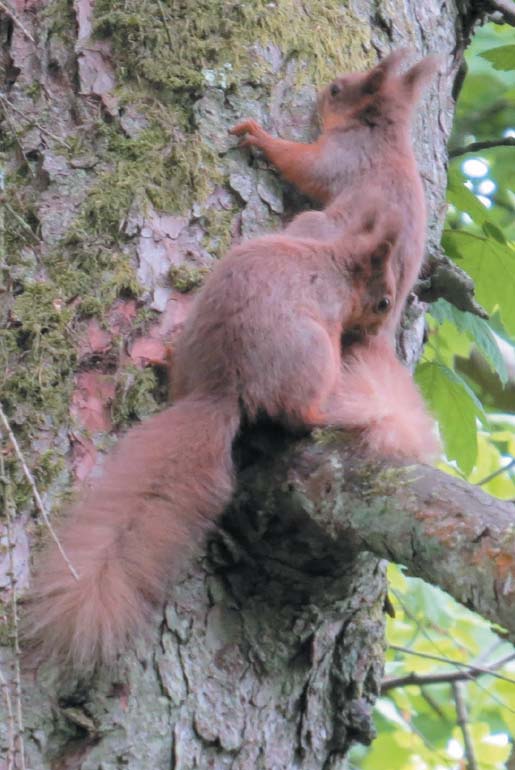| Wildlife
Newsletter for the Township of Dalkey July 2015 - Michael Ryan |
Red squirrels on Dalkey Hill Photo: M.Ryan |
|
It’s
always nice to see red squirrels on Dalkey or Killiney Hills and this
particular morning in late May we’d already got very excited after
seeing one individual but it headed off in a hurry, throwing itself
from branch to branch and
eventually disappearing into the leaf canopy. We continued up the hill
then Lucy spotted another red then realised there was a pair together
in a big larch tree, chasing each other around the trunk. We assembled
a delighted little crowd around us as we pointed out the reds to them
till the squirrels moved up into the denser branches. We made our way
to the cafe, very happy with our sighting. |
In recent years we’d gone out in Stephen Newton, BirdWatch Ireland’s senior seabird officer’s inflatable. The boat, though handy for wedging in between rocks to land, had its best years well behind it and the fact it needed constant re inflating wasn’t too reassuring. So, in the comparative luxury of Ken’s boat with 60 kilos of gravel, four new nest boxes, big chunks of stone to weigh them down with and the four of us we crossed over on a lovely sunny morning. I’d seen the first terns there the previous Tuesday, already mating and courting, the male birds offering sandeels to the females. Stephen had predicted they might already have eggs even after just five days and sure enough after landing he had a quick scan and came back to tell us to be careful where we stood since some birds had already laid. The eggs would stay warm in the sunshine for a while but we didn’t want to delay too long keeping the parent birds off their clutches. We spread the gravel and weighed down the new boxes watched by a pair of curious seals swimming a few yards off the rock and dozens of terns wheeling and calling overhead. We kept spotting new clutches and a final count of the eggs revealed 25 nests. No roseates so far but hopefully the commons and arctics will have a good season. BirdWatch South Dublin Branch members will be on hand with telescopes at the viewing area at Coliemore for seabird watching every Tuesday in July from 6.30 to 8.00pm. The following day coming through the woods on Killiney Hill we came across another recently fledged family of Treecreepers. When these delightful little birds leave the nest they crouch motionless, often in bunched groups of four and five against tree trunks where the adults will bring food to them. There was still an active Treecreepers nest in a piece of dead wood on a big beech tree where the parents were still bringing food but we’d came across at least two, possibly three other Treecreeper families whose young had already left the nest. Although very small birds and often overlooked as they move upward pressed against tree trunks they have lovely plumage, snow white on the underside and lovely mottled subtle browns on the back, perfect camouflage when the bird is against a tree bark. |
 Red squirrels on Dalkey Hill Photo: M.Ryan |
|
Their
curved bill, designed to pick out insects and their eggs from tiny
cracks on the tree, is possibly the thinnest bill of any of our bird
species. We were making our way to see if the other Treecreepers were
bringing food to the nest in the beech tree when we stopped short
as the most distinct of bird calls echoed through the woods, a cuckoo!
We followed the calls but couldn’t see it. Almost
every year a cuckoo arrives and calls on Dalkey or Killiney Hill for
just a day or two but I certainly wasn’t expecting to hear one
this late, the last day of May. We headed on and were walking round
the Hill above the Vico when on the top of Dalkey Hill that unmistakable,
long tail and hawk like pointed wings silhouette of the cuckoo flew
above the Monterey Pines. Last year it had been calling near the same
area not far from the aircraft beacon. Could it have thought that
area of high ground was potentially somewhere a meadow pipit might
nest and provide a home for the cuckoo’s offspring? A couple
of decades ago a meadow pipit did display in the area, singing as
it rose up beside the Telegraph Tower, but I don’t think it
ever nested and I haven’t seen any around there since but presumably
the cuckoo instinctively knows the type of habitat its host species
might nest in. |